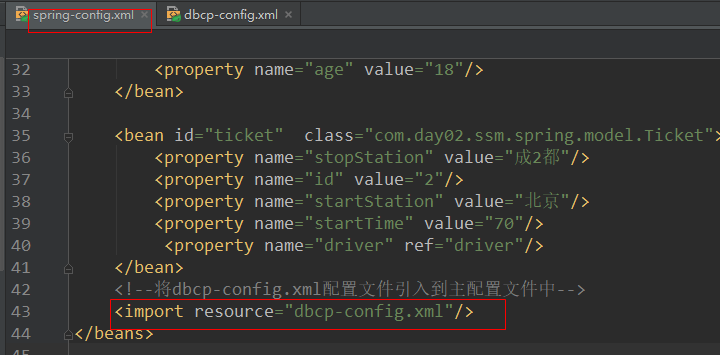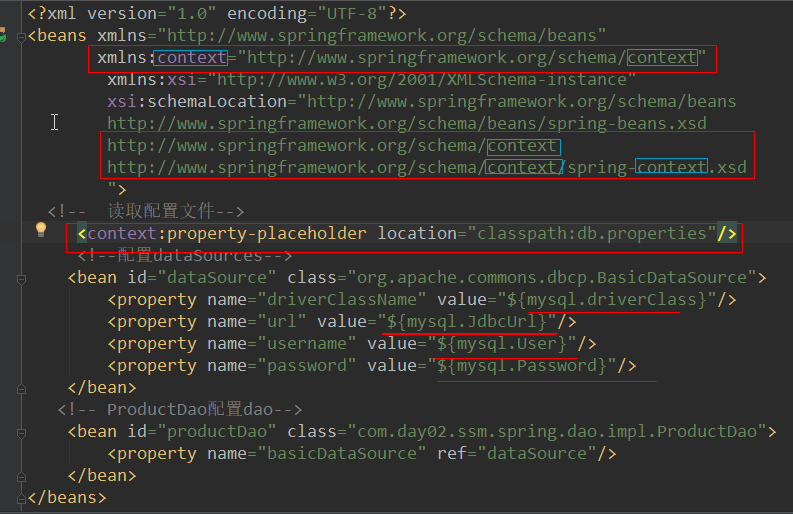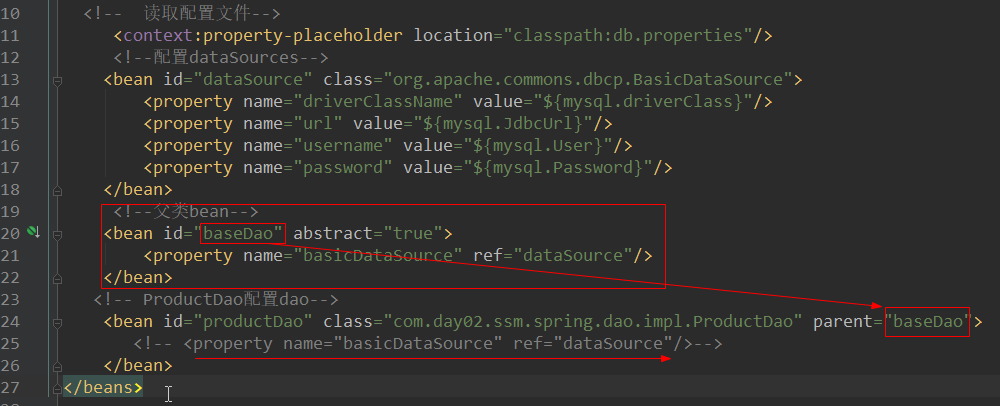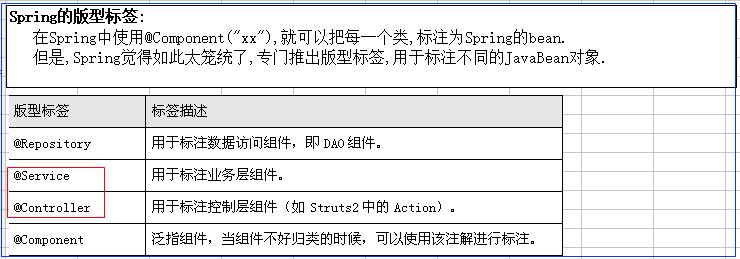05_ssm基础(四)之Spring基础二
24.spring配置dbcp并完成CRUD操作
1.准备jar包

2.编辑Product模型
package com.day02.ssm.spring.model;
public class Product{
private Integer id;
private String productName; //产品名称
private Integer salePrice;
private Integer costPrice;
public Integer getId() {
return id;
}
public void setId(Integer id) {
this.id = id;
}
public String getProductName() {
return productName;
}
public void setProductName(String productName) {
this.productName = productName;
}
public Integer getSalePrice() {
return salePrice;
}
public void setSalePrice(Integer salePrice) {
this.salePrice = salePrice;
}
public Integer getCostPrice() {
return costPrice;
}
public void setCostPrice(Integer costPrice) {
this.costPrice = costPrice;
}
}
Product
3.编辑接口
package com.day02.ssm.spring.dao; import com.day02.ssm.spring.model.Product; import java.sql.SQLException; /**
* 课程笔记:http://www.cnblogs.com/newAndHui/category/1153640.html
* 疑问咨询wx:851298348
*/
public interface IProductDao {
//增
public void save(Product product) throws SQLException;
//删
public void delete(int id);
//改
public void update(Product product);
//查
public Product query(int id); }
IProductDao
4.编辑实现类
package com.day02.ssm.spring.dao.impl; import com.day02.ssm.spring.dao.IProductDao;
import com.day02.ssm.spring.model.Product;
import org.apache.commons.dbcp.BasicDataSource; import java.sql.Connection;
import java.sql.PreparedStatement;
import java.sql.SQLException; /**
* 课程笔记:http://www.cnblogs.com/newAndHui/category/1153640.html
* 疑问咨询wx:851298348
*/
public class ProductDao implements IProductDao {
private BasicDataSource basicDataSource;
@Override
public void save(Product product) {
try {
//连接
Connection connection = basicDataSource.getConnection();
String sql = "INSERT INTO product (product_name,sale_price) VALUES (?,?)";
//创建编译语句
PreparedStatement preparedStatement = connection.prepareStatement(sql);
preparedStatement.setString(1,product.getProductName());
preparedStatement.setInt(2,product.getSalePrice());
//执行
preparedStatement.executeUpdate();
//释放
preparedStatement.close();
connection.close();
} catch (SQLException e) {
e.printStackTrace();
}
} @Override
public void delete(int id) { } @Override
public void update(Product product) { } @Override
public Product query(int id) {
return null;
} public BasicDataSource getBasicDataSource() {
return basicDataSource;
} public void setBasicDataSource(BasicDataSource basicDataSource) {
this.basicDataSource = basicDataSource;
}
}
ProductDao
5.编写spring配置文件bdcp-config.xml
<?xml version="1.0" encoding="UTF-8"?>
<beans xmlns="http://www.springframework.org/schema/beans"
xmlns:xsi="http://www.w3.org/2001/XMLSchema-instance"
xsi:schemaLocation="http://www.springframework.org/schema/beans
http://www.springframework.org/schema/beans/spring-beans.xsd">
<!--配置dataSources-->
<bean id="dataSource" class="org.apache.commons.dbcp.BasicDataSource">
<property name="url" value="jdbc:mysql://localhost:3306/station_data"/>
<property name="username" value="root"/>
<property name="password" value="admin"/>
</bean>
<!-- ProductDao配置dao-->
<bean id="productDao" class="com.day02.ssm.spring.dao.impl.ProductDao">
<property name="basicDataSource" ref="dataSource"/>
</bean>
</beans>
dbcp-config.xml
6.将bdcp-config.xml配置文件引入到主配置文件中(非常容易忘记)

7.测试dao
package com.day02.ssm.spring.test; import com.day02.ssm.spring.dao.impl.ProductDao;
import com.day02.ssm.spring.model.Product;
import com.day02.ssm.spring.model.Ticket;
import org.junit.Test;
import org.junit.runner.RunWith;
import org.springframework.beans.factory.BeanFactory;
import org.springframework.beans.factory.annotation.Autowired;
import org.springframework.test.context.ContextConfiguration;
import org.springframework.test.context.junit4.SpringJUnit4ClassRunner; /**
* 课程笔记:http://www.cnblogs.com/newAndHui/category/1153640.html
* 疑问咨询wx:851298348
*/
@RunWith(SpringJUnit4ClassRunner.class)//把junit加载到spring容器中去
@ContextConfiguration("classpath:spring-config.xml")
public class TestProductDao { // private ProductDao productDao=new ProductDao();
@Autowired
private ProductDao productDao;//从spring中获取dao对象
@Test
public void test(){
Product product = new Product();
product.setProductName("苹果");
product.setSalePrice(89);
productDao.save(product);
} }
TestProductDao
25.spring中的硬编码解决
1.配置文件

2.使用

26.spring中的继承使用

27.Autowired详细讲解
Autowired和Qualifier标签:
1.通过@Autowired标签可以让Spring自动的把属性需要的对象从Spring容器中找出来,并注入给该属性。(生产上就用这一招)
2.第三方程序:Spring3.0之前,需要手动配置@Autowired解析注解程序,Spring就会自动的加入针对@Autowired标签的解析程序。从Spring3.0开始,可以不再需要改配置了,但是只能在Spring容器中才生效.。
<context:annotation-config />,
无论使用哪一个版本,都得配置.
3.@Autowired标签贴在字段或者setter方法上。
4.@Autowired可以同时为一个属性注入多个对象。
public void setXxx(OtherBean1 other1,OtherBean2 other2) {}
5.使用@Autowired标签可以注入Spring内置的重要对象,比如BeanFactory,ApplicationContext。
@RunWith(SpringJUnit4ClassRunner.class)
@ContextConfiguration
public class SpringTest {
@Autowired
private ApplicationContext ctx;
}
6.默认情况下@Autowired标签必须要能找到对应的对象,否则报错。不过,可使用required=false来避免该问题:@Autowired(required=false)
7.@Autowired找bean的方式:
1)、首先按照依赖对象的类型找,如果找到则使用setter方法或者字段直接注入;
2)、如果在Spring上下文中找到多个匹配的类型,再按照名字去找,如果没有匹配则报错;
3)、可以通过使用@Qualifier("otherBean")标签来规定依赖对象按照bean的id+类型去找;
public class SomeBean {
@Autowired
private OtherBean1 other1;
@Autowired(required = false)
@Qualifier("otherbean2")
private OtherBean2 other2;
public String toString() {
return "SomeBean [other=" + other1 + ", other2=" + other2 + "]";
}
}
演示代码:
SomeBean
package com.day02.ssm.spring.model2; import org.springframework.beans.factory.annotation.Autowired;
import org.springframework.beans.factory.annotation.Qualifier; /**
* 课程笔记:http://www.cnblogs.com/newAndHui/category/1153640.html
* 疑问咨询wx:851298348
*/
public class SomeBean {
private String name;
//添加OtherBean1对象
@Autowired
@Qualifier("otherBean11")
private OtherBean1 otherBean1;
private OtherBean2 otherBean2; public String getName() {
return name;
} public void setName(String name) {
this.name = name;
}
// @Autowired
/* public void setOtherBean1(OtherBean1 otherBean1) {
this.otherBean1 = otherBean1;
}*/
/* @Autowired
public void setTwo(OtherBean1 otherBean1,OtherBean2 otherBean2) {
System.out.println("==otherBean1=============otherBean2=====");
this.otherBean1 = otherBean1;
this.otherBean2 = otherBean2; }*/
}
SomeBean
OtherBean1
package com.day02.ssm.spring.model2; /**
* 课程笔记:http://www.cnblogs.com/newAndHui/category/1153640.html
* 疑问咨询wx:851298348
*/
public class OtherBean1 {
private String name; public String getName() {
return name;
} public void setName(String name) {
this.name = name;
}
}
OtherBean1
OtherBean2
package com.day02.ssm.spring.model2; /**
* 课程笔记:http://www.cnblogs.com/newAndHui/category/1153640.html
* 疑问咨询wx:851298348
*/
public class OtherBean2 {
private String name; public String getName() {
return name;
} public void setName(String name) {
this.name = name;
}
}
OtherBean2
spring配置文件
<?xml version="1.0" encoding="UTF-8"?>
<beans xmlns="http://www.springframework.org/schema/beans"
xmlns:xsi="http://www.w3.org/2001/XMLSchema-instance"
xmlns:context="http://www.springframework.org/schema/context"
xsi:schemaLocation="http://www.springframework.org/schema/beans
http://www.springframework.org/schema/beans/spring-beans.xsd
http://www.springframework.org/schema/context
http://www.springframework.org/schema/context/spring-context.xsd">
<!--开启注解-->
<context:annotation-config/>
<!--把someBean交给spring管理-->
<bean id="someBean" class="com.day02.ssm.spring.model2.SomeBean">
<property name="name" value="someBean-1"/>
</bean> <!--把OtherBean1交给spring管理-->
<bean id="otherBean17" class="com.day02.ssm.spring.model2.OtherBean1">
<property name="name" value="otherBean1-1"/>
</bean> <bean id="otherBean11" class="com.day02.ssm.spring.model2.OtherBean1">
<property name="name" value="otherBean1-11"/>
</bean> <!--把OtherBean2交给spring管理-->
<bean id="otherBean2" class="com.day02.ssm.spring.model2.OtherBean2">
<property name="name" value="otherBean2-2"/>
</bean>
</beans>
测试代码
package com.day02.ssm.spring.model2; import org.junit.Test;
import org.junit.runner.RunWith;
import org.springframework.beans.factory.annotation.Autowired;
import org.springframework.context.ApplicationContext;
import org.springframework.test.context.ContextConfiguration;
import org.springframework.test.context.junit4.SpringJUnit4ClassRunner; /**
* 课程笔记:http://www.cnblogs.com/newAndHui/category/1153640.html
* 疑问咨询wx:851298348
*/
@RunWith(SpringJUnit4ClassRunner.class)//把junit加载到spring容器中去
@ContextConfiguration("classpath:spring-config2.xml")
public class TestSomeBean { @Autowired(required = false)
private SomeBean someBean;
// @Autowired
// private ApplicationContext ctx; @Test
public void test() {
// SomeBean someBean = (SomeBean) ctx.getBean("someBean11");
System.out.println("someBean"+ someBean);
} }
TestSomeBean
28.Resource标签
@Resource标签:
1,@Resource标签是JavaEE规范的标签;
2,@Resource标签也可以作用于字段或者setter方法;
3,也可以使用@Resource标签注入一些spring内置的重要对象,比如BeanFactory.ApplicationContext;
4,@Resource必须要求有匹配的对象;
5,<context:annotation-config>既引入了@Autowired标签的解析器,也引入了@Resource的解析器;
6,@Resource标签找bean的方式:
1),首先按照名字去找,如果找到,就使用setter或者字段注入;
2),如果按照名字找不到,再按照类型去找,但如果找到多个匹配类型,报错;
3),可以直接使用name属性指定bean的名称;但是,如果指定的name,就只能按照name去找,如果找不到,就不会再按照类型去找;
public class SomeBean {
@Resource(name="otherBean1")
private OtherBean1 other1;
@Resource(name="otherBean2")
private OtherBean2 other2;
public String toString() {
return "SomeBean [otherBean=" + other1 + ", otherBean2="
+ other2 + "]";
}
@Resource(name = "other1") 和 @Autowired ,@Qualifier("other1")选用:
1:使用Autowired标签,让代码和Spring耦合在一起,若某一天不使用Spring,就得改源代码. 重点:生产上一般使用:Autowired
2:Resource标签,本身就是javaEE的,本身不存在耦合问题.
随便使用哪一组,要求:都得掌握.
29.使用注解简化IoC
使用标签简化IoC:
1.使用标签来完成IoC,就必须有IoC标签的解析器
使用context:component-scan来扫描spring需要管理的bean
base-package就告诉spring,去哪些包及其子包里去扫描bean,如果有多个包需要被扫描;只需要用逗号隔开多个包即可
<!-- 扫描包-->
<context:component-scan base-package="com.day02.ssm.spring.model2" />
<!--开启注解-->
<context:annotation-config/>
2.标注Bean的注解:@Component
默认情况,直接使用类的名字(首字母小写作为bean的名字)
如果要修改bean的名称;直接使用value属性来重新定义bean的名称
@Component("otherbean")
public class OtherBean {}

Spring的零配置

IoC和DI操作,选用注解还是XML?
1):使用XML,直观,侵入性低,统一配置.
2):使用注解,简单,快速,不是很直观,让配置分散.
有时候,只能使用xml,不能使用注解?
比如配置一个DataSource.
你不可能去DataSource类上去贴标签.
一般的,我们使用xml做统一的配置,若有特殊的配置,可以使用注解来辅助.
二者都得掌握.
05_ssm基础(四)之Spring基础二的更多相关文章
- 05_ssm基础(四)之Spring与持久层的整合
30.31.spring对jdbc的支持jdbcTemplate 使用Spring的JDBC准备: 1):拷贝jar: mysql-connector-java-5.1.11.jar:M ...
- 05_ssm基础(三)之Spring基础
11.spring入门引导 12.spring_HelloWord程序 实现步骤: 0.找到spring压缩包,并解压 1.拷贝jar包 2.添加主配置文件(官方文档约28页) 3.在测试中使用 13 ...
- Bootstrap<基础四> 代码
Bootstrap 允许您以两种方式显示代码: 第一种是 <code> 标签.如果您想要内联显示代码,那么您应该使用 <code> 标签. 第二种是 <pre> 标 ...
- spring cloud系列教程第四篇-Eureka基础知识
通过前三篇文章学习,我们搭建好了两个微服务工程.即:order80和payment8001这两个服务.有了这两个基础的框架之后,我们将要开始往里面添加东西了.还记得分布式架构的几个维度吗?我们要通过一 ...
- Spring基础系列-AOP源码分析
原创作品,可以转载,但是请标注出处地址:https://www.cnblogs.com/V1haoge/p/9560803.html 一.概述 Spring的两大特性:IOC和AOP. AOP是面向切 ...
- Spring基础系列-Spring事务不生效的问题与循环依赖问题
原创作品,可以转载,但是请标注出处地址:https://www.cnblogs.com/V1haoge/p/9476550.html 一.提出问题 不知道你是否遇到过这样的情况,在ssm框架中开发we ...
- Spring基础3
一.AOP 1)AOP简介: Aspect Oriented Programming,面向切面编程 通过预编译方式和动态代理实现程序功能的一种技术,AOP是OOP的延续,是函数式编程的一种衍生范例.利 ...
- Java基础-SSM之Spring的AOP编程
Java基础-SSM之Spring的AOP编程 作者:尹正杰 版权声明:原创作品,谢绝转载!否则将追究法律责任. Spring的本质说白了就是动态代理,接下来我们会体验AOP的用法.它是对OOP的 ...
- 基础知识(09) -- Spring 概述
Spring概述-------------------------------------------------------------------------主要内容: 1.Spring是什么 2 ...
随机推荐
- SVG 学习<五> SVG动画
目录 SVG 学习<一>基础图形及线段 SVG 学习<二>进阶 SVG世界,视野,视窗 stroke属性 svg分组 SVG 学习<三>渐变 SVG 学习<四 ...
- ROS学习手记 - 5 理解ROS中的基本概念_Services and Parameters
上一节完成了对nodes, Topic的理解,再深入一步: Services and Parameters 我不理解为何 ROS wiki 要把service与parameter放在一起介绍, 很想分 ...
- 1.1使用java数组,并开始封装我们自己的数组
今天感冒了,全身酸软无力,啥样不想做,就来学习吧,此节我们从初步使用java中提供的数组,然后分析相关情况,过渡到封装我们自己的数组. 一.我们先来感受一下java提供的数组,以整型数组(int[]) ...
- yum-cron更新 CentOS yum update 不升级内核版本方法
http://www.360doc.com/content/15/0608/17/15798950_476597844.shtml 相关yum-cron说明有一些 CentOS yum update ...
- Git安装和基本使用(1)
参考廖雪峰GIt教程 https://www.liaoxuefeng.com/wiki/0013739516305929606dd18361248578c67b8067c8c017b000/00137 ...
- 图文详解AO打印(端桥模式)(转)
一.概述 AO打印是英文Active-Online Print的简称,也称主动在线打印.打印前支持AO通讯协议的AO打印机首先通过普通网络与C-Lodop服务保持在线链接,网页程序利用JavaSc ...
- 深度学习原理与框架-Tensorflow基本操作-mnist数据集的逻辑回归 1.tf.matmul(点乘操作) 2.tf.equal(对应位置是否相等) 3.tf.cast(将布尔类型转换为数值类型) 4.tf.argmax(返回最大值的索引) 5.tf.nn.softmax(计算softmax概率值) 6.tf.train.GradientDescentOptimizer(损失值梯度下降器)
1. tf.matmul(X, w) # 进行点乘操作 参数说明:X,w都表示输入的数据, 2.tf.equal(x, y) # 比较两个数据对应位置的数是否相等,返回值为True,或者False 参 ...
- day28-面相对象的特殊成员、内置函数
1. isinstance与issubclass 1.1.isinstance(obj,cls) 检查obj是否是类cls的对象,或者是类cls的子类的对象 class A: pass class B ...
- 数据结构:Stack
Stack设计与实现 Stack基本概念 栈是一种 特殊的线性表 栈仅能在线性表的一端进行操作 栈顶(Top):允许操作的一端 栈底(Bottom):不允许操作的一端 Stack的常用操作 创建栈 销 ...
- Linux:简单的并发服务器实现
我前两天实现了一个简单的服务器和一个对应的客户端,也简单的解决了一些错误检查和常用的函数的封装,但是那个服务器的一次只能连接一个客户端,鸡肋,太鸡肋了,今天我来实现可以连接多个客户端的服务器实例:多进 ...
